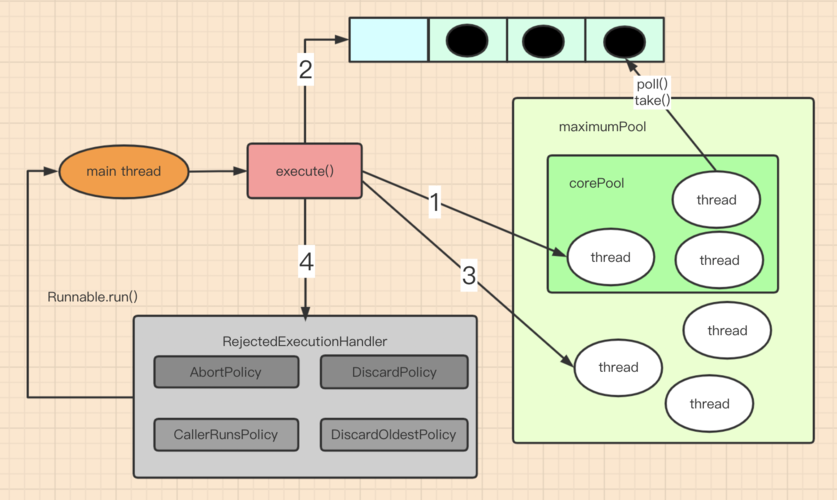C++11 加入了线程库,从此告别了标准库不支持并发的历史。然而 c++ 对于多线程的支持还是比较低级,稍微高级一点的用法都需要自己去实现,譬如线程池、信号量等。
线程池(thread pool)这个东西,在面试上多次被问到,一般的回答都是:“管理一个任务队列,一个线程队列,然后每次取一个任务分配给一个线程去做,循环往复。” 貌似没有问题吧。但是写起程序来的时候就出问题了。
废话不多说,先上实现,然后再啰嗦。(dont talk, show me ur code !)
代码实现
#pragma once
#ifndef THREAD_POOL_H
#define THREAD_POOL_H
#include < vector >
#include < queue >
#include < atomic >
#include < future >
//#include < condition_variable >
//#include < thread >
//#include < functional >
#include < stdexcept >
namespace std
{
//线程池最大容量,应尽量设小一点
#define THREADPOOL_MAX_NUM 16
//#define THREADPOOL_AUTO_GROW
//线程池,可以提交变参函数或拉姆达表达式的匿名函数执行,可以获取执行返回值
//不直接支持类成员函数, 支持类静态成员函数或全局函数,Opteron()函数等
class threadpool
{
using Task = function< void() >; //定义类型
vector< thread > _pool; //线程池
queue< Task > _tasks; //任务队列
mutex _lock; //同步
condition_variable _task_cv; //条件阻塞
atomic< bool > _run{ true }; //线程池是否执行
atomic< int > _idlThrNum{ 0 }; //空闲线程数量
public:
inline threadpool(unsigned short size = 4) { addThread(size); }
inline ~threadpool()
{
_run=false;
_task_cv.notify_all(); // 唤醒所有线程执行
for (thread& thread : _pool) {
//thread.detach(); // 让线程“自生自灭”
if(thread.joinable())
thread.join(); // 等待任务结束, 前提:线程一定会执行完
}
}
public:
// 提交一个任务
// 调用.get()获取返回值会等待任务执行完,获取返回值
// 有两种方法可以实现调用类成员,
// 一种是使用 bind:.commit(std::bind(&Dog::sayHello, &dog));
// 一种是用 mem_fn:.commit(std::mem_fn(&Dog::sayHello), this)
template< class F, class... Args >
auto commit(F&& f, Args&&... args) - >future< decltype(f(args...)) >
{
if (!_run) // stoped ??
throw runtime_error("commit on ThreadPool is stopped.");
using RetType = decltype(f(args...)); // typename std::result_of< F(Args...) >::type, 函数 f 的返回值类型
auto task = make_shared< packaged_task< RetType() >>(
bind(forward< F >(f), forward< Args >(args)...)
); // 把函数入口及参数,打包(绑定)
future< RetType > future = task- >get_future();
{ // 添加任务到队列
lock_guard< mutex > lock{ _lock };//对当前块的语句加锁 lock_guard 是 mutex 的 stack 封装类,构造的时候 lock(),析构的时候 unlock()
_tasks.emplace([task](){ // push(Task{...}) 放到队列后面
(*task)();
});
}
#ifdef THREADPOOL_AUTO_GROW
if (_idlThrNum < 1 && _pool.size() < THREADPOOL_MAX_NUM)
addThread(1);
#endif // !THREADPOOL_AUTO_GROW
_task_cv.notify_one(); // 唤醒一个线程执行
return future;
}
//空闲线程数量
int idlCount() { return _idlThrNum; }
//线程数量
int thrCount() { return _pool.size(); }
#ifndef THREADPOOL_AUTO_GROW
private:
#endif // !THREADPOOL_AUTO_GROW
//添加指定数量的线程
void addThread(unsigned short size)
{
for (; _pool.size() < THREADPOOL_MAX_NUM && size > 0; --size)
{ //增加线程数量,但不超过 预定义数量 THREADPOOL_MAX_NUM
_pool.emplace_back( [this]{ //工作线程函数
while (_run)
{
Task task; // 获取一个待执行的 task
{
// unique_lock 相比 lock_guard 的好处是:可以随时 unlock() 和 lock()
unique_lock< mutex > lock{ _lock };
_task_cv.wait(lock, [this]{
return !_run || !_tasks.empty();
}); // wait 直到有 task
if (!_run && _tasks.empty())
return;
task = move(_tasks.front()); // 按先进先出从队列取一个 task
_tasks.pop();
}
_idlThrNum--;
task();//执行任务
_idlThrNum++;
}
});
_idlThrNum++;
}
}
};
}
#endif
代码不多吧,上百行代码就完成了 线程池, 并且, 看看 commit, 哈, 不是固定参数的, 无参数数量限制! 这得益于可变参数模板.
怎么使用?
#include "threadpool.h"
#include < iostream >
void fun1(int slp)
{
printf(" hello, fun1 ! %dn" ,std::this_thread::get_id());
if (slp >0) {
printf(" ======= fun1 sleep %d ========= %dn",slp, std::this_thread::get_id());
std::this_thread::sleep_for(std::chrono::milliseconds(slp));
}
}
struct gfun {
int operator()(int n) {
printf("%d hello, gfun ! %dn" ,n, std::this_thread::get_id() );
return 42;
}
};
class A {
public:
static int Afun(int n = 0) { //函数必须是 static 的才能直接使用线程池
std::cout < < n < < " hello, Afun ! " < < std::this_thread::get_id() < < std::endl;
return n;
}
static std::string Bfun(int n, std::string str, char c) {
std::cout < < n < < " hello, Bfun ! "< < str.c_str() < < " " < < (int)c < < " " < < std::this_thread::get_id() < < std::endl;
return str;
}
};
int main()
try {
std::threadpool executor{ 50 };
A a;
std::future< void > ff = executor.commit(fun1,0);
std::future< int > fg = executor.commit(gfun{},0);
std::future< int > gg = executor.commit(a.Afun, 9999); //IDE提示错误,但可以编译运行
std::future< std::string > gh = executor.commit(A::Bfun, 9998,"mult args", 123);
std::future< std::string > fh = executor.commit([]()- >std::string { std::cout < < "hello, fh ! " < < std::this_thread::get_id() < < std::endl; return "hello,fh ret !"; });
std::cout < < " ======= sleep ========= " < < std::this_thread::get_id() < < std::endl;
std::this_thread::sleep_for(std::chrono::microseconds(900));
for (int i = 0; i < 50; i++) {
executor.commit(fun1,i*100 );
}
std::cout < < " ======= commit all ========= " < < std::this_thread::get_id()< < " idlsize="<
为了避嫌,先进行一下版权说明:代码是 me “写”的,但是思路来自 Internet, 特别是这个线程池实现。
实现原理
接着前面的废话说。“管理一个任务队列,一个线程队列,然后每次取一个任务分配给一个线程去做,循环往复。” 这个思路有神马问题?
线程池一般要复用线程,所以如果是取一个 task 分配给某一个 thread,执行完之后再重新分配,在语言层面基本都是不支持的:一般语言的 thread 都是执行一个固定的 task 函数,执行完毕线程也就结束了(至少 c++ 是这样)。
so 要如何实现 task 和 thread 的分配呢?让每一个 thread 都去执行调度函数:循环获取一个 task,然后执行之。idea 是不是很赞!保证了 thread 函数的唯一性,而且复用线程执行 task 。
即使理解了 idea,代码还是需要详细解释一下的。
- 一个线程 pool,一个任务队列 queue ,应该没有意见;
- 任务队列是典型的生产者-消费者模型,本模型至少需要两个工具:一个 mutex + 一个条件变量,或是一个 mutex + 一个信号量。mutex 实际上就是锁,保证任务的添加和移除(获取)的互斥性,一个条件变量是保证获取 task 的同步性:一个 empty 的队列,线程应该等待(阻塞);
- atomic 本身是原子类型,从名字上就懂:它们的操作 load()/store() 是原子操作,所以不需要再加 mutex。
c++语言细节
即使懂原理也不代表能写出程序,上面用了众多c++11的“奇技淫巧”,下面简单描述之。
- using Task = function 是类型别名,简化了 typedef 的用法。function 可以认为是一个函数类型,接受任意原型是 void() 的函数,或是函数对象,或是匿名函数。void() 意思是不带参数,没有返回值。
- pool.emplace_back([this]{...}) 和 pool.push_back([this]{...}) 功能一样,只不过前者性能会更好;
- pool.emplace_back([this]{...}) 是构造了一个线程对象,执行函数是拉姆达匿名函数 ;
- 所有对象的初始化方式均采用了 {},而不再使用 () 方式,因为风格不够一致且容易出错;
- 匿名函数:[this]{...} 不多说。[] 是捕捉器,this 是引用域外的变量 this指针, 内部使用死循环, 由cv_task.wait(lock,[this]{...}) 来阻塞线程;
- delctype(expr) 用来推断 expr 的类型,和 auto 是类似的,相当于类型占位符,占据一个类型的位置;auto f(A a, B b) -> decltype(a+b) 是一种用法,不能写作 decltype(a+b) f(A a, B b),为啥?!c++ 就是这么规定的!
- commit 方法是不是略奇葩!可以带任意多的参数,第一个参数是 f,后面依次是函数 f 的参数!(注意:参数要传struct/class的话,建议用pointer,小心变量的作用域) 可变参数模板是 c++11 的一大亮点,够亮!至于为什么是 Arg... 和 arg... ,因为规定就是这么用的!
- commit 直接使用只能调用stdcall函数,但有两种方法可以实现调用类成员,一种是使用 bind:.commit(std::bind(&Dog::sayHello, &dog));一种是用 mem_fn:.commit(std::mem_fn(&Dog::sayHello), &dog);
- make_shared 用来构造 shared_ptr 智能指针。用法大体是 shared_ptr p = make_shared(4) 然后 *p == 4 。智能指针的好处就是, 自动 delete !
- bind 函数,接受函数 f 和部分参数,返回currying后的匿名函数,譬如 bind(add, 4) 可以实现类似 add4 的函数!
- forward() 函数,类似于 move() 函数,后者是将参数右值化,前者是... 肿么说呢?大概意思就是:不改变最初传入的类型的引用类型(左值还是左值,右值还是右值);
- packaged_task 就是任务函数的封装类,通过 get_future 获取 future , 然后通过 future 可以获取函数的返回值(future.get());packaged_task 本身可以像函数一样调用 () ;
- queue 是队列类, front() 获取头部元素, pop() 移除头部元素;back() 获取尾部元素,push() 尾部添加元素;
- lock_guard 是 mutex 的 stack 封装类,构造的时候 lock(),析构的时候 unlock(),是 c++ RAII 的 idea;
- condition_variable cv; 条件变量, 需要配合 unique_lock 使用;unique_lock 相比 lock_guard 的好处是:可以随时 unlock() 和 lock()。cv.wait() 之前需要持有 mutex,wait 本身会 unlock() mutex,如果条件满足则会重新持有 mutex。
- 最后线程池析构的时候,join() 可以等待任务都执行完在结束,很安全!
-
封装
+关注
关注
127文章
8033浏览量
143535 -
程序
+关注
关注
117文章
3798浏览量
81501 -
C++
+关注
关注
22文章
2114浏览量
73932 -
线程池
+关注
关注
0文章
57浏览量
6901
发布评论请先 登录
相关推荐
C语言线程池的实现方案
Java中的线程池包括哪些

《深入理解C++11》C++11新特性解析与应用的详细电子教材免费下载
Spring 的线程池应用

如何用C++11实现自旋锁





 基于C++11的线程池实现
基于C++11的线程池实现















评论